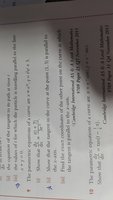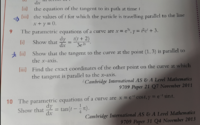please help parameteic equation maths
- Thread starter deviany
- Start date
yoscar04
Full Member
- Joined
- Jun 3, 2020
- Messages
- 274
For 8(iii) you need to use the definition of v: haven't you learnt that v=(dx/dt,dy/dt)?
For 9(ii) how did you get t=2? If you substitute t=2 in your equation dy/dx you never will get 0.
Try to find the t that corresponds to x=1, y=3.
For 9(ii) how did you get t=2? If you substitute t=2 in your equation dy/dx you never will get 0.
Try to find the t that corresponds to x=1, y=3.
Last edited:
in 9ii, the question asks you to show that at (1,3) the tangent to the curve is parallel to the x-axis, that is, show the slope is 0 at (1,3).
(evaluate something to get 0 and you are done)
what you tried to do is part iii. (solve equation set equal to 0)
(evaluate something to get 0 and you are done)
what you tried to do is part iii. (solve equation set equal to 0)
HallsofIvy
Elite Member
- Joined
- Jan 27, 2012
- Messages
- 7,763
My neck hurts!Please post images right side up.
HallsofIvy
Elite Member
- Joined
- Jan 27, 2012
- Messages
- 7,763
Thank you! That helps a lot.
Problem 9 gives parametric equations x=e3t, y=t2et+3. dx/dt=3e3t, dy/dt=2tet+t2et=et(t2+2t). dxdy=dtdxdtdy=3e3tet(t2+2t)=(t2+2t)e−2t. That is the same as the given 3e2tt(t+2).
At x= 1, y= 3, x=1=e3t so t= 0 (as a check y=02e0+3=3). With t= 0, the derivative, whether we use (t2+2t)e−2t or 3e2tt(t+2), is 0 so the tangent line is horizontal, parallel to the x- axis.
The tangent line will be horizontal wherever dy/dx=3e2tt(t+2)=0. A fraction is 0 if and only if the numerator is 0: t(t+ 2)= 0 so either t= 0 or t= -2. The other point where the tangent line is parallel to the x-axis is (e3(−2),(−2)2e−2+3)=(e−6,4e−2+3).
Problem 9 gives parametric equations x=e3t, y=t2et+3. dx/dt=3e3t, dy/dt=2tet+t2et=et(t2+2t). dxdy=dtdxdtdy=3e3tet(t2+2t)=(t2+2t)e−2t. That is the same as the given 3e2tt(t+2).
At x= 1, y= 3, x=1=e3t so t= 0 (as a check y=02e0+3=3). With t= 0, the derivative, whether we use (t2+2t)e−2t or 3e2tt(t+2), is 0 so the tangent line is horizontal, parallel to the x- axis.
The tangent line will be horizontal wherever dy/dx=3e2tt(t+2)=0. A fraction is 0 if and only if the numerator is 0: t(t+ 2)= 0 so either t= 0 or t= -2. The other point where the tangent line is parallel to the x-axis is (e3(−2),(−2)2e−2+3)=(e−6,4e−2+3).


